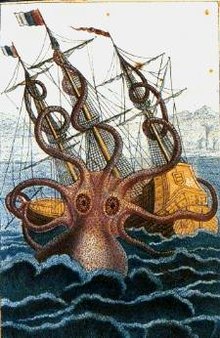Giant octopus (mythology)

Gigantic, aggressive cephalopods , in German colloquial language giant octopuses (sometimes called kraken as in the English-speaking world ), which supposedly attack ships and people and pull them into the depths, are an integral part of many mythologies regardless of time, culture and continent. In the past, these legends were dismissed as mere seaman's yarn , but contemporary science revised the picture and was able to prove that animals, which may have been the model of these mythical creatures, basically exist.
Reports
The sea monster "Kraken" has been part of Norse mythology for centuries. In the Sverris saga about King Sverre Sigurdsson , written in the 12th century, he is one of the monsters the protagonist encounters. He was a colossal creature, the size of an island that could sink ships. Often the Kraken was equated with other mythical sea monsters, including the biblical Leviathan . Originally several kilometers long, its size has shrunk over the centuries to still enormous, ship-sinking proportions. He either pulls the ships down with his arms or creates a maelstrom . Although a man-eating monster, good things were said about it: the octopus would be accompanied by a large school of fish that promised bold sailors a rich catch. According to Erik Pontoppidan , in his work The natural history of Norway (1752), the octopus was 2.5 kilometers long, reports of floating islands in the sea would in fact refer to it. Even the founder of modern scientific taxonomy, Carl von Linné , included it in the first edition of his work Systema Naturae under the name Microcosmus marinus , but removed it as a mythological creature himself from the later editions.
In terms of poetry , the monster was immortalized in the famous poem The Kraken by the English poet Alfred Tennyson . He also appears in the adventure novel 20,000 Leagues Under the Sea by the French writer Jules Verne .
Zoological role models
The legend could be modeled on the deep-sea-dwelling giant squids , which leave scars on the skin of sperm whales with their suction cups and reach a considerable size. At all times, dead specimens have been found on coasts. It is unknown whether there may be other giant squid at great depths from which the legends about the octopus may have originated.
literature
- P. Werner Lange: Sea monsters - fables and facts . VEB FA Brockhaus Verlag, Leipzig, 1979.
- Rodrigo B. Salvador & Barbara M. Tomotani: The Kraken: when myth encounters science. História, Ciências, Saúde - Manguinhos, Rio de Janeiro, v.21, n.3, 2014: 971–994.